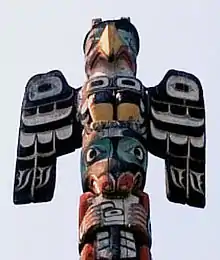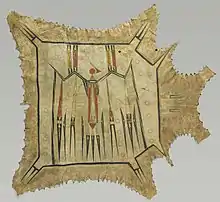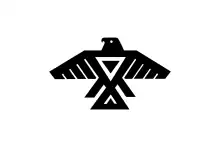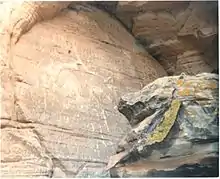 | |
| Grouping | Legendary creature |
|---|---|
| Similar entities | Rain Bird, Pamola |
| Folklore | Indigenous peoples of the Americas |
| Region | North America |

The thunderbird is a legendary creature in particular North American indigenous peoples' history and culture. It is considered a supernatural being of power and strength.
It is especially important and frequently depicted in the art, songs, and oral histories of many Pacific Northwest Coast cultures, but is also found in various forms among some peoples of the American Southwest, East Coast of the United States, Great Lakes, and Great Plains. In modern times it has achieved notoriety as a purported cryptid, similar to creatures such as Bigfoot and the Loch Ness Monster.
General description
The thunderbird is said to create thunder by flapping its wings (Algonquian[1]), and lightning by flashing its eyes (Algonquian, Iroquois[2]).
Algonquian
The thunderbird myth and motif is prevalent among Algonquian peoples in the Northeast, i.e., Eastern Canada (Ontario, Quebec, and eastward) and Northeastern United States, and the Iroquois peoples (surrounding the Great Lakes).[3] The discussion of the Northeast region has included Algonquian-speaking people in the Lakes-bordering U.S. Midwest states (e.g., Ojibwe in Minnesota[4]).
In Algonquian mythology, the thunderbird controls the upper world while the underworld is governed by the underwater panther or Great Horned Serpent. The thunderbird creates not just thunder (with its wing-flapping) but lightning bolts, which it casts at the underworld creatures.[1]
Thunderbirds in this tradition may be depicted as a spreadeagled bird (wings horizontal head in profile), but also quite common with the head facing forward, thus presenting an X-shaped appearance overall[4] (see under §Iconography below).
Ojibwe

The Ojibwe version of the myth states that the thunderbirds were created by Nanabozho to fight the underwater spirits. Thunderbirds also punished humans who broke moral rules. The thunderbirds lived in the four directions and arrived with the other birds in the springtime. In the fall, they migrated south after the end of the underwater spirits' most dangerous season.[5]
Menominee

The Menominee of Northern Wisconsin tell of a great mountain that floats in the western sky on which dwell the thunderbirds. They control the rain and hail, and delight in fighting and deeds of greatness. They are the enemies of the great horned snakes (the Misikinubik) and have prevented these from overrunning the earth and devouring humankind. They are messengers of the Great Sun himself.[6]
Siouan

The thunderbird motif is also seen in Siouan-speaking peoples, which include tribes traditionally occupying areas around the Great Lakes.
Ho-Chunk
Ho-Chunk tradition states that a man who has a vision of a thunderbird during a solitary fast will become a war chief of the people.[7]
Arikara
Ethnographer George Amos Dorsey transcribed a tale from the Arikaras with the title The Boy who befriended the Thunderbirds and the Serpent: a boy named Antelope-Carrier finds a nest with four young thunderbirds; their mother comes and tells the human boy that a two-headed Serpent comes out of the lake to eat the young.[8]
Iconography

X-shapes
In Algonquian images, an X-shaped thunderbird is often used to depict the thunderbird with its wings alongside its body and the head facing forwards instead of in profile.[3]
The depiction may be stylized and simplified. A headless X-shaped thunderbird was found on an Ojibwe midewiwin disc dating to 1250–1400 CE.[9] In an 18th-century manuscript (a "daybook" ledger) written by the namesake grandson of Governor Matthew Mayhew, the thunderbird pictograms varies from "recognizable birds to simply an incised X".[10]
Non-indigenous scientific interpretations

American science historian and folklorist Adrienne Mayor and British historian Tom Holland have both suggested that indigenous thunderbird stories are based on discoveries of pterosaur fossils by Native Americans.[11][12] However, it has also been noted by tribal historians, despite variations (note: much Indigenous references are verbal and difficult to reference), the typical design elements of the motif within different tribal groups across the continent appear distinct from the makeup of the suggested prehistoric flying reptile, such as eagle or raptor-like avian feathered wings and tail, along with a vastly different head shape, perhaps with the exception of some Pacific Northwest imagery.
In modern usage
- Thunderbird is the name of an operator in the popular competitive shooter Tom Clancy's Rainbow Six: Siege.
- The Ford Thunderbird took its name from the Thunderbird.
- In 1925, Aleuts were recorded as using the term to describe the Douglas World Cruiser aircraft which passed through Atka on the first aerial circumnavigation by a US Army team the previous year.[13]: 100
- The Pokémon Zapdos is based on First Nations folklore surrounding the Thunderbird.[14]
- The Thunderbird is part of the Harry Potter franchise, and plays a significant role in Fantastic Beasts and Where to Find Them.
- Thunderbirds are the name used for the sports teams at Southern Utah University, in Cedar City, UT.
- Thunderbirds are the name used for the sports teams at the University of British Columbia, Vancouver campus.
- It is the namesake of the Seattle Thunderbirds of the Western Hockey League, as well as being depicted in the team's logo.
- Thunderbird is a Bolliger and Mabillard Launched Wing Coaster that opened at Holiday World & Splashin' Safari in Santa Claus, Indiana in 2015.
- The Thunderbird is a second to last boss in The Legend of Zelda II: The Adventure of Link.
_a_Kwakwaka'wakw_big_house.jpg.webp)
- Mozilla Thunderbird is a free and open-source cross-platform email client.
- Thunderbird is the sixth track on the album The Spine by They Might Be Giants.
- One of the Miraculous in the Native American Miracle Box in Miraculous: Tales of Ladybug and Cat Noir is the Thunderbird Miraculous.
- The Thunderbird is the cap badge and symbol of the [Canadian Forces Military Police] since 1968.
See also
References
- 1 2 Cleland, Chute & Haltiner (1984), p. 240
- ↑ Lenik (2012), p. 163
- 1 2 Lenik (2012), p. 163.
- 1 2 Lenik (2012), p. 181.
- ↑ Vecsey, Christopher (1983). Traditional Ojibwa Religion and Its Historical Changes. Vol. 152. American Philosophical Society. p. 75. ISBN 978-0-87169-152-1.
- ↑ Lankford, George E. (2011). Native American Legends of the Southeast: Tales from the Natchez, Caddo, Biloxi, Chickasaw, and other Nations. Tuscaloosa, AL: University of Alabama Press. p. 77. ISBN 978-0-8173-5689-7.
- ↑ Burlin, Nathalie C. (1907). The Indians' Book: An Offering by the American Indians of Indian Lore, Musical and Narrative, to Form a Record of the Songs and Legends of Their Race. Harper and Brothers.
- ↑ Dorsey, George Amos. Traditions of the Arikara. Washington: Carnegie Institution of Washington, 1904. pp. 73-79, 187.
- ↑ Bouck & Richardson (2007), p. 15, citing Cleland (1984), p. 240, figure 2C; Lenik (1985), p. 132, figure 5.
- ↑ Bouck & Richardson (2007), p. 15.
- ↑ Mayor, Adrienne (2005). Fossil Legends of the First Americans. ISBN 0-691-11345-9.
- ↑ "BBC Four - Dinosaurs, Myths and Monsters".
- ↑ Thomas, Lowell (1925). The First World Flight. Boston & New York: Houghton Mifflin Company.
- ↑ "17 Pokemon based on real-world mythology". 4 February 2014.
Sources
- Bouck, Jill; Richardson, James B. III (2007). "Enduring Icon: A Wampanoag Thunderbird on an Eighteenth Century English Manuscript From Martha's Vineyard". Archaeology of Eastern North America. 35: 11–19. JSTOR 40914506.
- Cleland, Charles E.; Chute, Richard D.; Haltiner, Robert E. (1984). "NAUB-COW-ZO-WIN Discs from Northern Michigan". Midcontinental Journal of Archaeology. 9 (2): 235–249. JSTOR 20707933.
- Lenik, Edward J. (2012). "The Thunderbird Motif in Northeastern Indian Art". Archaeology of Eastern North America. 40: 163–185. JSTOR 23265141.
External links
 Media related to Thunderbird (mythology) at Wikimedia Commons
Media related to Thunderbird (mythology) at Wikimedia Commons


.svg.png.webp)
